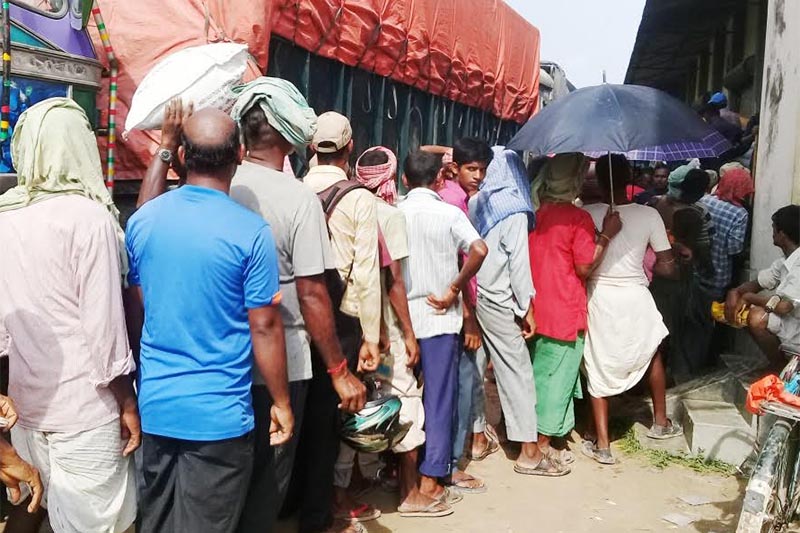Uncertainty in fertiliser distribution riles farmers
KATHMANDU, SEPTEMBER 4
Farmers in the country were pinning their hopes on a good harvest this year due to the favourable monsoon. But in lack of fertilisers, they are helplessly watching their hopes fade away, while the concerned authorities seem busy blaming one another for the delay in distribution.
On one hand, the Ministry of Agriculture and Livestock Development cited the negligence of the contractor and COVID-19 pandemic as the reasons for the delayed import of fertilisers. On the other hand, Salt Trading Corporation (STC) and Agriculture Inputs Company Ltd (AICL) have blamed the lengthy bureaucratic process to get their proposals approved for the delay in import.
In the last fiscal year, the government had targeted to bring 450,000 tonnes of fertilisers, of which only half has been imported till date. Meanwhile, for the current fiscal year, MoALD has allocated budget for the first quarter to both STC and AICL.
Of the last fiscal’s target, AICL has imported 276,000 tonnes of fertilisers so far, while 50,000 tonnes are yet to arrive. According to the company, it will take 15 more days for the fertilisers to reach Kolkata.
This basically means that it is unlikely that the farmers will get fertilisers from AICL any time soon.
On the other side, for the current fiscal year AICL has handed over tender to bring 110,000 tonnes of urea, 95,000 tonnes of DAP and 10,000 tonnes of potash.
Meanwhile, STC has imported 32,000 tonnes of fertilisers, of which 21,000 tonnes is an order of the last fiscal year and 11,000 tonnes is an order of the first quarter of the current fiscal year.
“Every year, MoALD used to give permission for the entire year, but this fiscal the ministry has allowed us to import fertilisers for the first quarter only,” said Kumar Rajbhandari, spokesperson for STC.
He further claimed that the government always allocates less budget for fertilisers due to which the farmers have to suffer. Moreover, the lengthy process of MoALD also affects the import process, and thus, shortage of fertilisers is a recurrent issue every year, he added.
For the first quarter of the current fiscal year, STC has to import 30,000 tonnes of urea fertilisers, of which 11,000 tonnes have already arrived and it has called a tender for the remaining 19,000 tonnes.
Meanwhile, STC has to bring 40,000 tonnes of DAP, of which a tender has been called for 20,000 tonnes.
Likewise, STC has also called a tender to import 5,000 tonnes of potash.
According to Navaraj Basnet, president of Nepal Farmer Group Federation (NFGF), farmers are bearing the brunt of the power play in the government, not to mention the lengthy processes of importing and distributing fertilisers.
“STC and AICL import the fertilisers, but they are distributed to the farmers via cooperatives, which is an extremely lengthy process and also raises its cost for us,” he said, “The government should amend its policies and implementation modalities.”
Meanwhile, Hari Bahadur KC, spokesperson for MoALD, claimed the pandemic and the resultant movement restrictions to curb the spread of the virus were a major problem due to which a large quantity of fertilisers was stranded in Kolkata for almost one-and-ahalf months. Besides, the negligence of the contractor was a new issue this year.
“Firstly, our consignment got stuck due to the pandemic.
Secondly, we had awarded the tender for fertiliser import to a Nepali firm this year hoping they would deliver it on time.
However, even though they were awarded the tender before the lockdown, they struggled with the processes and the import was delayed.”
Amid concerns of serpentine queues of farmers to get fertilisers amid the rapid spread of the virus, KC said, “The situation will be managed within a week or so.”
He also admitted that the recently issued directives to import and distribute fertilisers have also delayed the procurement process.
Currently, Nepal has been importing fertilisers from China, Gulf countries, Russia and Turkey. In the meantime, recently the government also approached Bangladesh for fertilisers.
A version of this article appears in e-paper on September 5, 2020, of The Himalayan Times.






